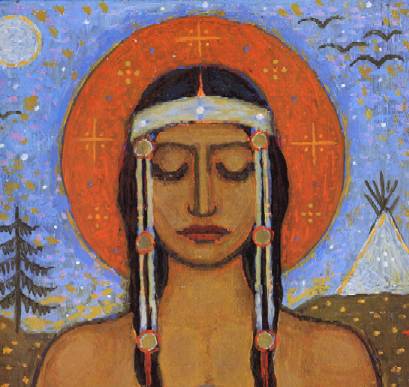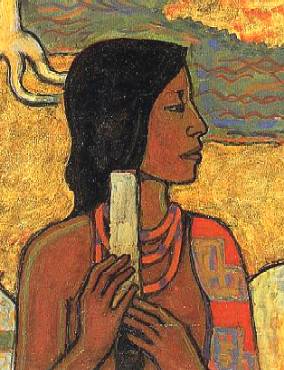Eve and Mary, and the salvation through woman
In Islam, woman is not regarded under her malefic aspect, since she is not involved in the fall of Adam; it is Iblis alone who causes the fall of the first couple and their exile from the earthly Paradise. In the conception of Jannah, "Garden" or Paradise, woman is spiritualized, not by virtue of an exceptional function analogous to that of "Co-Redemptress", but simply as the instrument of love, in the form of the Huris, "the gazelle-eyed"; besides, traditional Christian iconography nearly always represents angels with feminine features. It would be easy to give other and quite varied examples of the beatific symbolism of woman, for instance: Sita and Radha; the goddess Kali in the bhakti of Shri Ramakrishna; the wives of David, Solomon, Muhammad; the knights' ladies, such as Beatrice in the life and work of Dante. [The Eye of the Heart, p. 95, note 1.]
The profound explanation of the myths of the "sinful" woman, "prisoner" of chthonic powers, "ravished" by a demon, "swallowed" by the earth, or even become infernal -- Eve, Eurydice, Sita, Izanami, according to case -- this explanation doubtless is to be fond in the scission between the male demiurge and the female demiurge, or between the center and the periphery of the cosmos; this periphery being envisaged then, not as the cosmic substance as such, which remains virgin in relation to its production, but as the totality of these productions; for it is the accidents, and not the substance, which comprise "evil" in all its forms. But, aside from the fact that the substance remains virgin even while being mother, it is redeemed at the very level of its exteriorization through its positive contents, which are in principle sacramental and saving; symbolically speaking, if "woman" was lost through choosing "matter" or the "world", she was redeemed -- and is redeemed -- through giving birth to the Avatara. And besides, "everything is Atma"; and "it is not for the love of the husband (or of the wife or the son) that the husband (or the wife or the son) is dear, but for the love of Atma which in him". That is, the feminine element -- the Substance -- is by definition a mirror of the Essence, despite its exteriorizing and alienating function; moreover, a mirror is necessarily separated from what it reflects, and therein lies its ambiguity. [Survey of Metaphysics and Esoterism, p.53-54].
... one can make as much use as one likes of the fact that Eve's sin was to call Adam to the adventure of outwardness, but one cannot forget that the function of Mary was the opposite and that this function also enters into the possibility of the feminine spirit. Nethertheless the spiritual mission of woman will never be linked with a revolt against man... [Esoterism as Principle and as Way, p.142].

To allege that the woman who is holy has become a man by the fact of her sanctity, amounts to presenting her as a denatured being: in reality, a holy woman can only be such on the basis of her perfect femininity, failing which God would have been mistaken in creating woman - quod absit -- whereas according to Genesis she was, in the intention of God, "a helpmeet for man"; and so firstly a "help" and not an obstacle, and secondly "like unto him", and not a sub-human; to be accepted by God, she does not have to stop being what she is. (1) [Esoterism as Principle and as Way, p.143].
(1) Ave gratia plena, said the angel to Mary. "Full of grace": this settles the question given that Mary is a woman. The angel did not say Ave Maria, because to him gratia plena is the name that he gives to the Virgin, this amounts to saying that Maria is synonymous with gratia plena.
The key to the mystery of salvation through woman, or through femininity, if one prefers, lies in the very nature of Maya: If Maya can attract towards the outward, she can also attract towards the inward. Eve is life, and this is manifesting Maya; Mary is Grace, and this is reintegrating Maya. Eve personifies the demiurge under its aspect of femininity; Mary is the personification of the Shekhinah, of the Presence that is both virginal and maternal. Life, being amoral, can be immoral; Grace, being pure substance, is capable of absorbing all accidents. [Esoterism as Principle and as Way, p.143].
... Rûmi considers, with finesse and profundity and not without humor, that the sage is conquered by woman whereas the fool conquers her: for the latter is brutalized by his passion, and does not know the barakah of love and delicate sentiments, whereas the sage sees in the lovable woman a ray from God, and in the feminine body an image of creative Power. [Sufism, Veil and Quintessence, p. 69, note 19].
Femininity
The 'Eternal Feminine'
Eve and Mary
Man and Woman
The feminine body
Feminism

